The sharks in Cancun’s waters are simply doing their best to survive, just like anyone else. They really don’t plan to terrorize beaches and are just curious. It’s tough being curious without any way to check something out except for taste. With any luck, this article will paint a thorough picture of what to expect when you hop in the warm salty water of one of Mexicio’s favorite spots, Cancun.
Sharks get a pretty bad rap no matter where or what they do. These marine creatures just can’t seem to get a break. With the constant flow of anti-shark propaganda, whether at the movies or in the news, they just don’t stand much chance of being liked.
Sharks are apex predators, meaning they are top-of-the-line hunters, and much of the ocean’s creatures are their prey. Sharks may be at the top of the food chain, but so are humans. Humans are fantastic at being afraid of anything they don’t understand. By the close of this article, you might see sharks in a different light. It should help to know that in 400+ years, there have only been 42 shark attacks in any of the water surrounding Mexico. That’s one attack per year in more than 7,000 miles of the Mexican coast! Over half of those bites were provoked by the human who received the bite. None of the attacks were fatal. Being bitten by a shark is unlikely no matter where you are in the world, though the United States wins the gold medal for the most attacks worldwide.
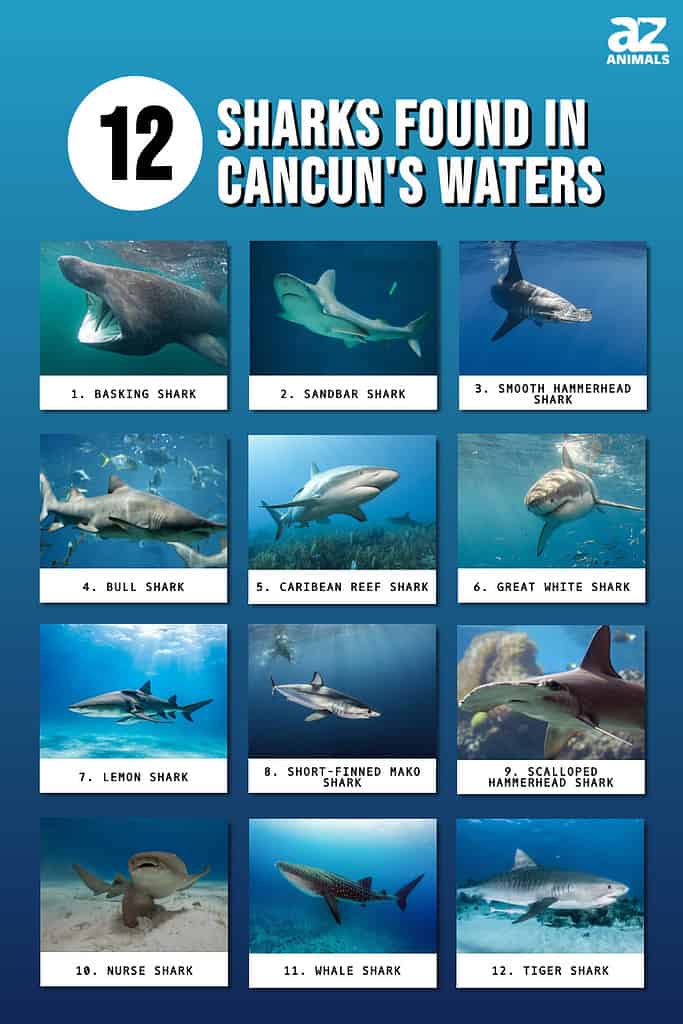
Takeaway
- On average, sharks attack and kill up to ten people every year. Humans annually kill about 20 to 30 million sharks, according to the Florida Museum of Natural History’s Department of Ichthyology. So who’s the real scary creature in the oceans: humans.
- Sharks bite when threatened because it is their only line of defense. They do not seek you out because they are hungry for human meat, in fact, humans apparently don’t taste good to them. If the bite is unprovoked, it’s an accident and they have mistaken you for prey they DO like.
- Most species of shark’s numbers are dwindling. They need our help. Many of these scary monster fish cannot reproduce fast enough to keep from becoming endangered, or worse, extinct. They live sometimes as long as we do and reach sexual maturity at the same time. Ocean babies can become quick snacks for larger fish. Just because a shark gives birth to 18 pups doesn’t mean that even half survive to maturity. Ocean life is tough.
- Most baby sharks are on their own the moment they are born and many are small enough to be eaten by fish and larger sharks. Their mother is not there to protect them. Some have umbilical cords but many do not. Instead, their mother produces unfertilized eggs to feed the sharks before they are born.
- The safety precautions for a safe ocean experience is much more than we have in the United States. It is extremely rare that anyone is bitten anywhere in Mexico’s oceans and even rarer yet that they are bit in the waters of Cancun, a million-dollar tourist area.
A Few More…
- The most dangerous places to swim in the ocean are Florida, New York, South Carolina, North Carolina, Hawaii, and Australia. The United States makes up roughly 70% of all attacks, with Florida claiming over half of those.
- All sharks hunt for food at dusk and at dawn.
- There have only been 17 attacks on people in 450 years in Cancun and most of those involved fishing or diving not near the shore. A kid was recently bitten though after a closer look, doctors do not believe it was a shark but instead a barracuda.
- Get in the beautiful, crystal clear Cancun water and try to just enjoy your time. It is highly unlikely that you will even see a shark and if you do, they likely want nothing to do with you so leave them alone.
1. Basking Shark (Cetorhinus maximus)

Basking sharks do not frequent the waters near Cancun, but they are present in the Caribbean, just as they are worldwide.
©Martin Prochazkacz/Shutterstock.com
Appearance: Very large, grey, huge 3-foot wide mouth with five enormous gills
Size: 33 feet long
Habitat: Everywhere from Brazil and the Caribbean to the four corners of the Atlantic, though the Caribbean and further south is a rare occurrence
Attacks in Mexico: 0
Attacks Worldwide: 0
The basking shark is one of the largest sharks out there and is entirely docile, nonaggressive, and doesn’t even have the correct type of teeth that it would take to bite a human. These gentle giants are seen near cruise ships in the open ocean. They prefer to glide along the sea’s surface, “basking.” If you happen to see one of these truly majestic creatures, you should know how lucky you are.
2. Sandbar Shark (Carcharhinus plumbeus)
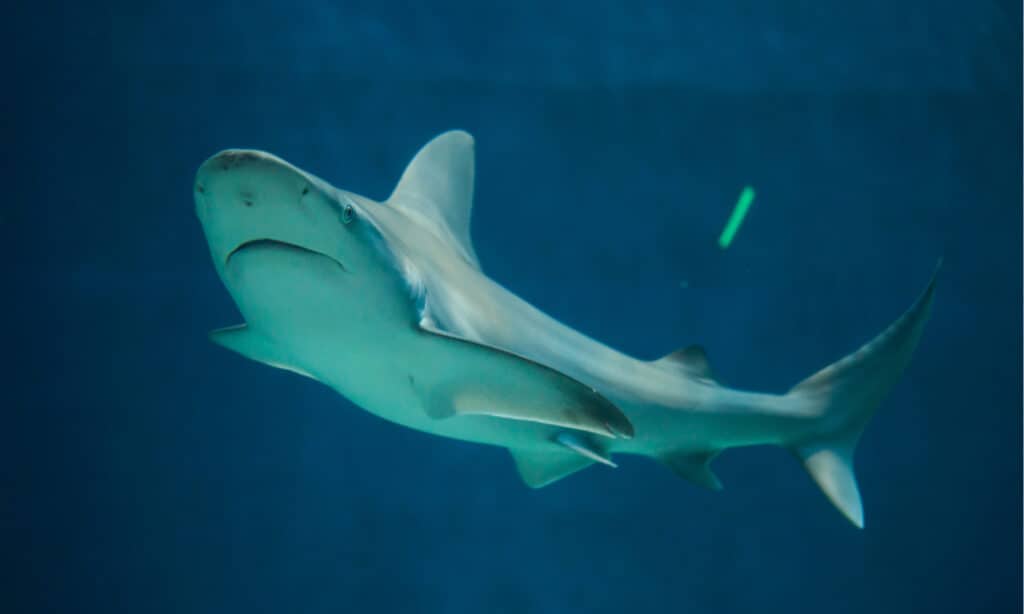
The sandbar shark is one of the largest sharks in the world and is closely related to the bull shark and the dusky shark.
©Vladimir Wrangel/Shutterstock.com
Appearance: Very heavy grey/blueish/bronze upper body with a pale or white underside with short rounded snouts
Size: 5.9 – 8.2 feet long
Habitat: Muddy and sandy shallow waters in bays, harbors, or the mouths of brackish rivers but are also known to dive 660 feet below the surface of the ocean
Attacks in Mexico: 0
Attacks Worldwide: 5 nonfatal
The sandbar shark may look scary, but humans are much more frightening to them than the sharks are to us. They are hunted for their large fins. They do not attack people and eat small crustaceans and fish on the sandbars. These giant sharks take the blame for a few attacks, but it’s relative; the bull shark is likely responsible for the attacks. The sandbar shark is not aggressive and tends to avoid humans and near the shore.
3. Smooth Hammerhead Shark (Sphyrna zygaena)

The smooth hammerhead shark (Sphyrna zygaena) is not endangered, but its number is declining worldwide.
©iStock.com/Michael Zeigler
Appearance: Light greenish grey, obvious hammer-shaped head
Size: 8.4 – 10 feet in length
Habitat: Shallow water that is less than 65 feet deep
Attacks in Mexico: 0
Attacks Worldwide: 18 nonfatal
Hammerhead sharks can be massive, but the smooth hammerhead is not gigantic. It mostly chooses to remain near the shore to chase schools of fish and search for crustaceans and cephalopods. They are also known to hunt other sharks, including their own species. Hammerheads are an aggressive species, and caution is essential if you see them while you are in the water, but they have yet to cause a fatality.
4. Bull Shark (Carcharhinus leucas)

Bull sharks are the most aggressive shark species along with great white and
tiger
sharks.
©bluehand/Shutterstock.com
Appearance: Light grey, stout body, rounded snout, snaggled-looking teeth
Size: 7 – 11 feet long
Habitat: Shallow warm water in oceans, canals, or rivers, and Lake Pontchartrain in New Orleans contains juveniles. They also like warm, muddy brackish water in rivers. They are most commonly seen near Yucatán and around the islands of Isla Mujeres, Cozumel, and Holbox
Attacks in Mexico: 0 confirmed
Attacks Worldwide: 93 nonfatal, 26 fatal
The male bull shark has very high testosterone, which makes it aggressive. These sharks tend to stay in shallow water and are responsible for 119 attacks worldwide. Even 119 episodes in 450 years aren’t much, especially knowing that some of those attacks were provoked by the person bitten.
The bull shark, also known as the Zambezi shark in Africa, can swim up rivers from the ocean and remain in brackish water. Most notably, the bull shark is able to swim far up the Mississippi River. Most of the attacks from the bull shark were likely mistaken identity of their meal or just out of curiosity. Curiosity or not, shark bites aren’t going to be pleasant. It is very rare that you will see one in the Cancun waters, but as always, better safe than sorry.
5. Caribean Reef Shark (Carcharhinus perezi)
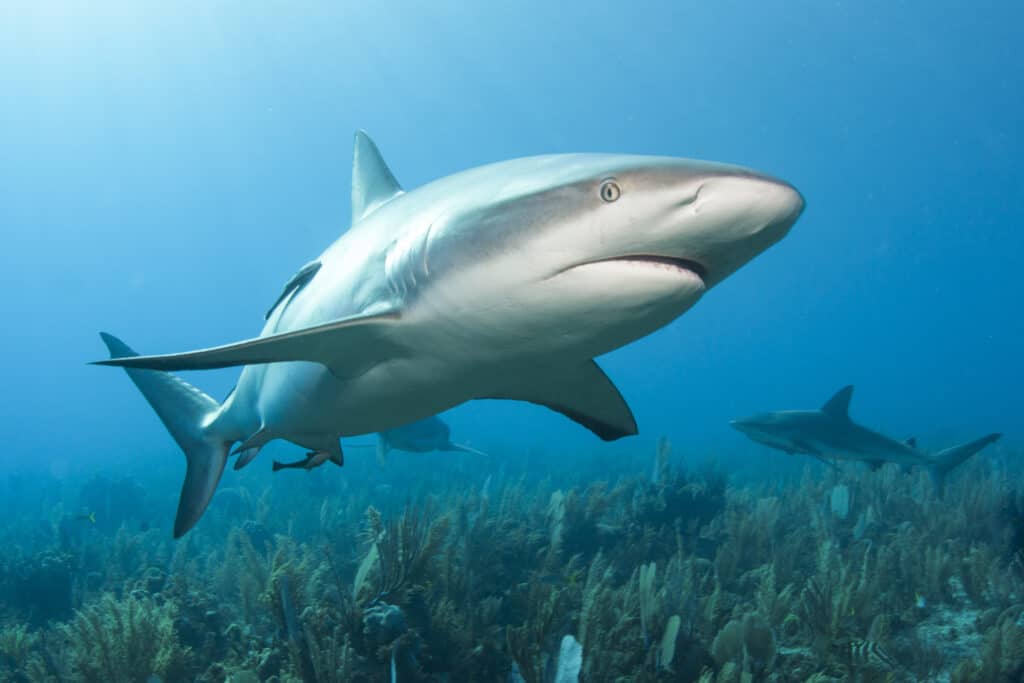
Reef sharks can grow quite large (7 feet), but they are not especially aggressive and dangerous to humans.
©Konstantin Novikov/Shutterstock.com
Appearance: Greyish brown upper with white underside
Size: Up to 10 feet long
Habitat: Prefers shallow water less than 100 feet deep
Attacks in Mexico: 0
Attacks Worldwide: 4 unprovoked nonfatal
The Caribbean reef shark is a relatively docile beast. However, it turns into a frantic ball of energy when food is around and hunts ferociously. There have been times when a reef shark accidentally bites a human while in a feeding frenzy, especially when those people are also fishing. This is an honest mistake; people must understand that the ocean is the shark’s home. Generally, nobody comes between us and food on a fork in our homes.
6. Great White Shark (Carcharodon carcharias)
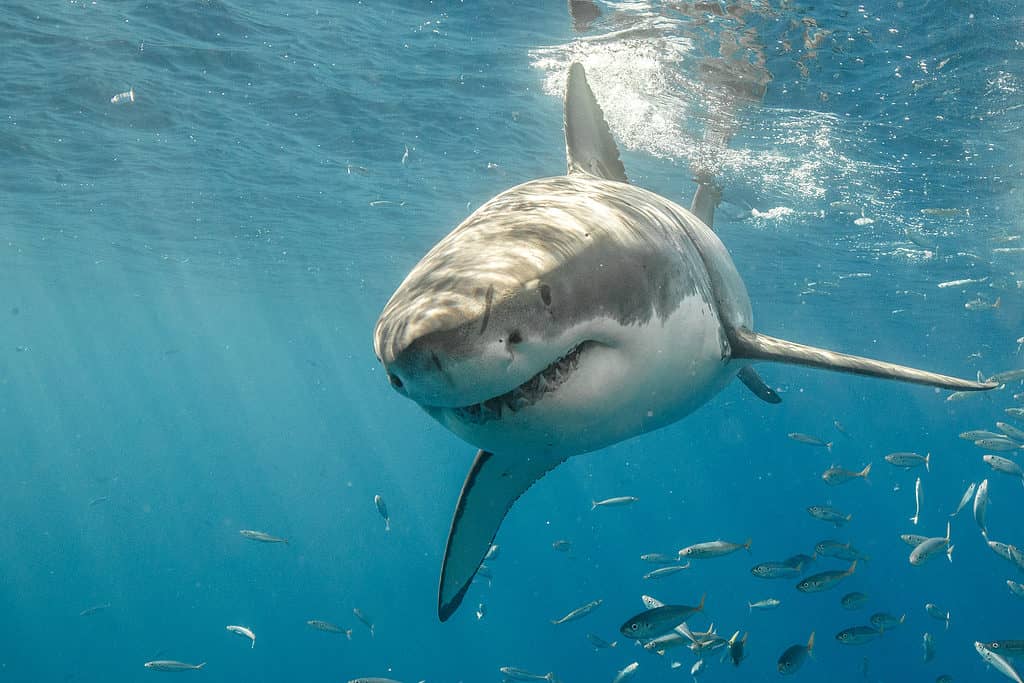
In recent reports, juvenile great white sharks are “hanging out” with surfers without a single attack ever.
©iStock.com/ShaneMyersPhoto
Appearance: Dark grey with a white underside
Size: Up to 20 feet long and 2,400 pounds
Habitat: Coastal surface water of all oceans
Attacks in Mexico: 1 fatal, 1 nonfatal
Attacks Worldwide: 292 nonfatal, 59 fatal
Great white sharks scare more people worldwide because of the movie Jaws than any other type of shark. Recent studies found that juvenile great white sharks do not attack people and sometimes swim very close to people and “hang out” around surfers and paddleboarders. Once they mature, their testosterone goes up, and they become much more aggressive. White sharks prefer to eat seals, sea lions, sea turtles, and stingrays. They do not actively want to eat a human because they don’t like how we taste.
These are aggressive sharks and they become more aggressive around food. Most shark attacks occur near piers where fishers dump their bait when finished, near people fishing, and around fishing boats. They have a highly sensitive sense of smell and tend to zone out in a feeding frenzy. Cancun is home to juvenile male white sharks from January through April yearly. You can swim with them and not worry too much about being at dinner.
7. Lemon Shark (Negaprion brevirostris)
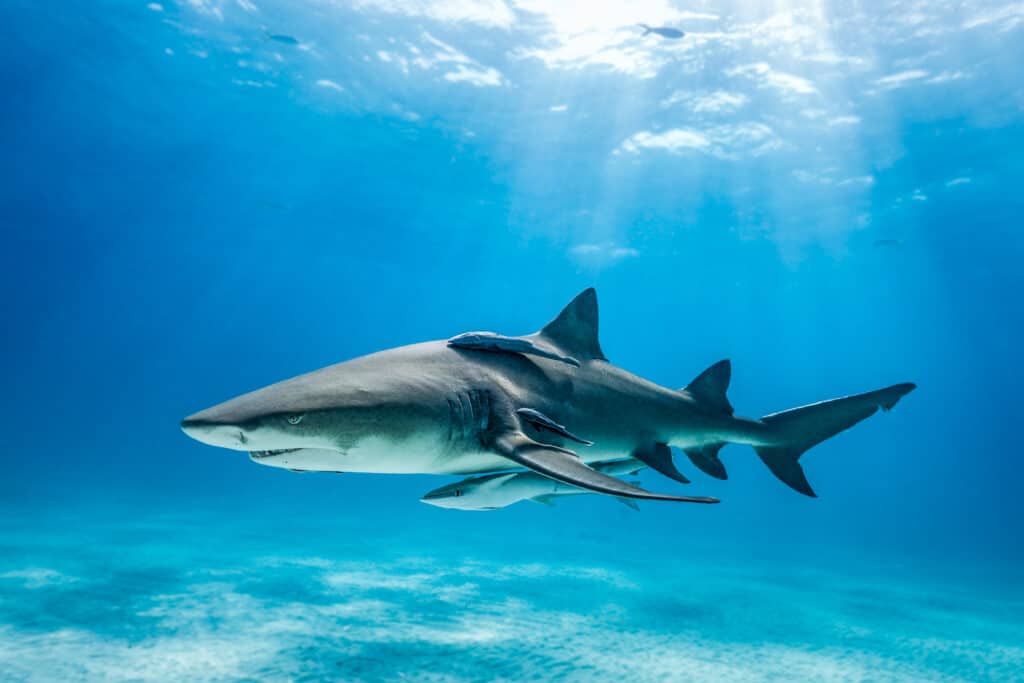
Lemon sharks can live to be 30 years old. They have no known predators other than humans.
©iStock.com/Michael Geyer
Appearance: Yellowish brown, pointed snout, and stocky body
Size: Up to 10.5 feet long
Habitat: Sandy or rocky-bottomed tropical warm waters
Attacks in Mexico: 0
Attacks Worldwide: 10 nonfatal attacks
Lemon sharks are social beings and have been okay with humans as long as they don’t feel threatened. They are generally harmless unless in the throws of a feeding frenzy. They breed in groups, and the female can have up to 18 pups from different fathers. Other sharks sometimes eat young adults, but the adult lemon shark does not have any known predators other than humans. They are hunted for their skin, fins, and meat.
8. Short-Finned Mako Shark (Isurus oxyrinchus)
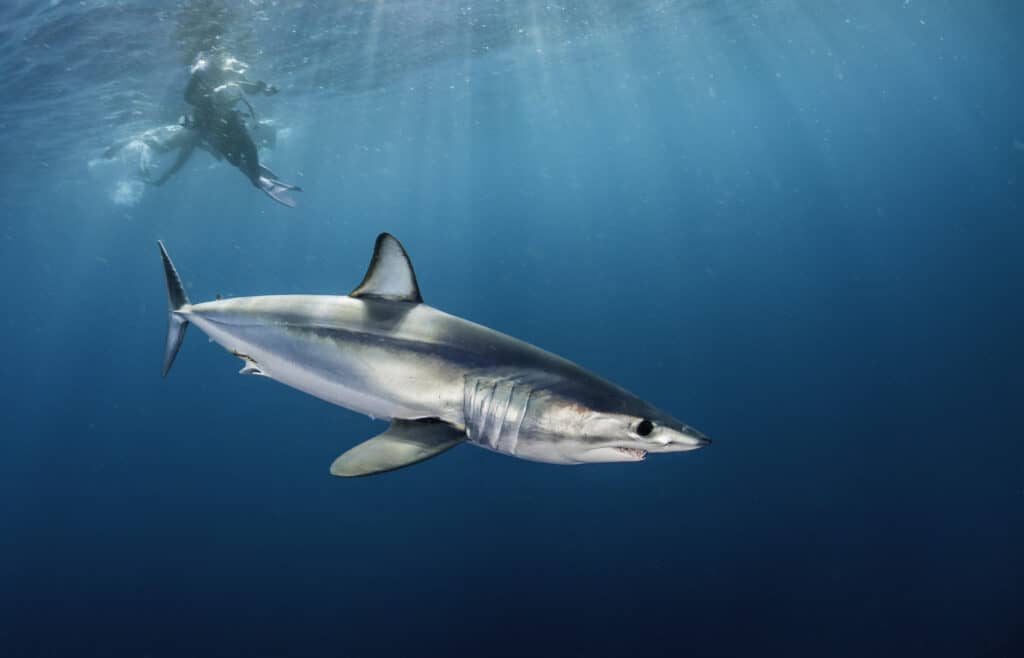
The short-finned mako is classified as endangered by the IUCN.
©wildestanimal/Shutterstock.com
Appearance: Dark grey upper and white underside with a long pointy snout
Size: Up to 15 feet long
Habitat: Warm tropical waters but occassionally travels to cooler parts of the ocean
Attacks in Mexico: 0
Attacks Worldwide: 9 nonfatal and 1 fatal, totaling 10 in 450 years
The short-finned mako shark is the fastest around and can hit 45 mph in short bursts. Short-finned mako sharks frequently launch themselves out of the water after prey. Though it is rare, attacks from these sharks have happened in the past. These large sharks prey on tuna, mackerel, swordfish, and other large ocean fish.
9. Scalloped Hammerhead Shark (Sphyrna lewini)

Scallopped hammerhead sharks are more docile than other hammerheads.
©Ian Scott/Shutterstock.com
Appearance: Hammer-shaped head with small indention in the center that looks chewed up and flawed along the edges, grey/brown upper and white underside, small mouth
Size: Up to 12 feet long
Habitat: Sandy or rocky ocean bottom looking for prey
Attacks in Mexico: 0
Attacks Worldwide: 17 of the Sphyrna sp. though none have been reported for specifically the Sphyrna lewini
The scalloped hammerhead shark is primarily a bottom dweller that spends a lot of time looking for stingrays to eat along the rocky and sandy bottom of the warm shallow waters. These sharks have small mouths, allowing them to take small bites. Due to the strange hammer-shaped head, they can pick up electrical impulses in the water from fish. Hammerhead sharks are inquisitive and will come over to check out divers, so it’s best to use keen judgment and respect these large animals.
10. Nurse Shark (Ginglymostoma cirratum)
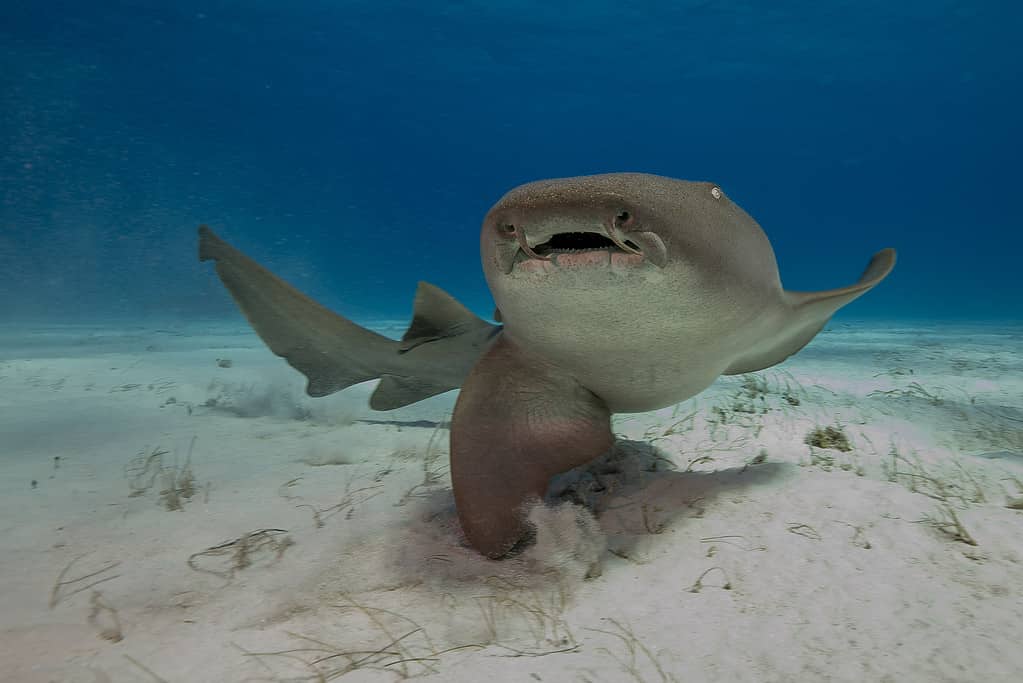
Nurse sharks are bottom dwellers that make a sucking noise as they suck up small crustaceans from the sandy seabed.
Appearance: Grey upper with a lighter grey underside, almost catfish-looking with small eyes and unique-looking mouth, small serrated teeth, and large fins
Size: Up to 15 feet long
Habitat: Sandy or rocky shallow water bottoms in warm temperate waters
Attacks in Mexico: 0
Attacks Worldwide:
Nurse sharks are the most common sharks in Cancun. They do not have large sharp teeth to tear flesh like most of the other sharks discussed. But instead, their bite is vise-like and crushing. It is doubtful that a nurse shark would be capable of killing a human even if it wanted to. However, they will attack if threatened. Nurse sharks are social animals and hang out with a group as large as 50 other nurse sharks. Once again, as evening falls, they become solitary hunters once again. These large fish may stay in groups as protection from danger. They are slow-moving, docile, and sleep all day.
11. Whale Shark (Rhincodon typus)

Whale sharks are giant, friendly majestic creatures that are hard to wrap your mind around being real. Their appearance is that of a mythical creature that appears yearly for a brief time and then vanishes again.
©Jan Finsterbusch/Shutterstock.com
Appearance: Massive and the largest fish in the ocean, dark greyish blue with white spots on the upper and white on the underside, very large mouth for inhaling tiny microorganisms
Size:18 – 39 feet long
Habitat: The open ocean and warmer waters in the Gulf of Mexico and Caribbean.
Attacks in Mexico: 0
Attacks Worldwide: 0
Whale sharks are unique creatures who are gentle and docile unless you’re a small shrimp, crustacean, small fish, or plankton. They eat by filtering out what they don’t want with their gill rakers. They swim in the open ocean with their enormous mouths open wide, sucking up the water and its inhabitants. Whale sharks migrate near Cancun from June through September. Whale sharks reach maturity at 30 years old and can live to be over 100. These beautiful beasts are the largest ocean inhabitants ever to live and are even larger than their prehistoric ancestors.
12. Tiger Shark (Galeocerdo cuvier)
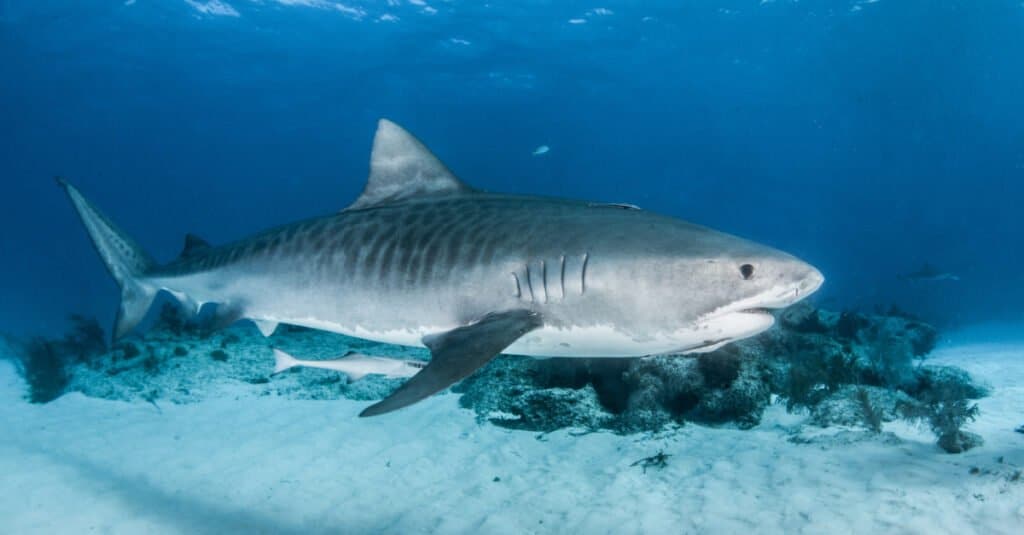
The
tiger shark
gets its name from the vertical lines that run along the side of its body and is closely related to the other highly aggressive species of shark, the bull shark.
©iStock.com/Divepic
Appearance: Stout, muscular bodies, white lower and grey upper, a pattern of dark grey spots or stripes along the sides, blunt-nosed with curved serrated teeth
Size: 13 – 25 feet long
Habitat: Temperate or tropical waters, estuaries, harbors to clear water lagoons and atolls, they tend to stay above 500 feet deep
Attacks in Mexico: Exact count unknown
Attacks Worldwide: 103 nonfatal and 32 fatal in 450 years
Tiger sharks are the trashcan of the sea because they will eat just about anything. This makes them more dangerous than great white sharks, who often swim away after mistakenly biting a human. The tiger shark’s bite may not be a mistake, and it will not likely swim away. They are some of the fiercest predators out there. Between their size and temperament, the tiger shark deserves respect.
Summary of The 12 Sharks Found in Cancun’s Waters
| Number | Shark |
|---|---|
| 1 | Basking Shark |
| 2 | Sandbar Shark |
| 3 | Smooth Hammerhead Shark |
| 4 | Bull Shark |
| 5 | Caribean Reef Shark |
| 6 | Great White Shark |
| 7 | Lemon Shark |
| 8 | Short-Finned Mako Shark |
| 9 | Scalloped Hammerhead Shark |
| 10 | Nurse Shark |
| 11 | Whale Shark |
| 12 | Tiger Shark |
FAQ
Q: What is the difference between a provoked and unprovoked shark attack?
A: A provoked attack happens when a human engages with a shark by harassing it, touching it, feeding it, or catching it while fishing. An unprovoked attack is when a human is in the ocean, unaware of the shark, and attacked without prior engagement.
Q: Has there been any shark attacks in Cancun?
A: Yes, but it is extremely rare. The water is clear and shallow near Cancun and Riviera Maya, which makes it impossible for large sharks to be in the areas where people are in the water. Making sure to keep a healthy distance between you and any shark you see is essential. If you use common sense, there is nothing to worry about.
Q: What is the best place to hit a shark if you’re attacked?
A: The best thing to do if a shark attacks you is to fight back. Punching or hitting them in the gills, nose, or face will generally get them to release you or go away completely. Remember, most bites are a mistake.
The photo featured at the top of this post is © Onusa Putapitak/Shutterstock.com
Thank you for reading! Have some feedback for us? Contact the AZ Animals editorial team.







